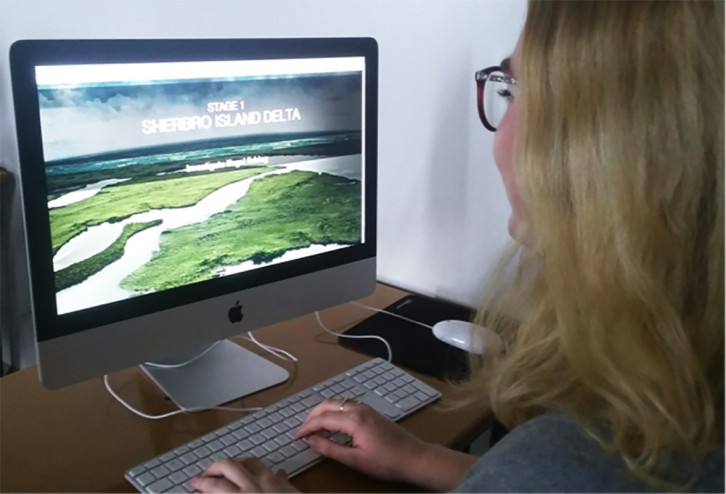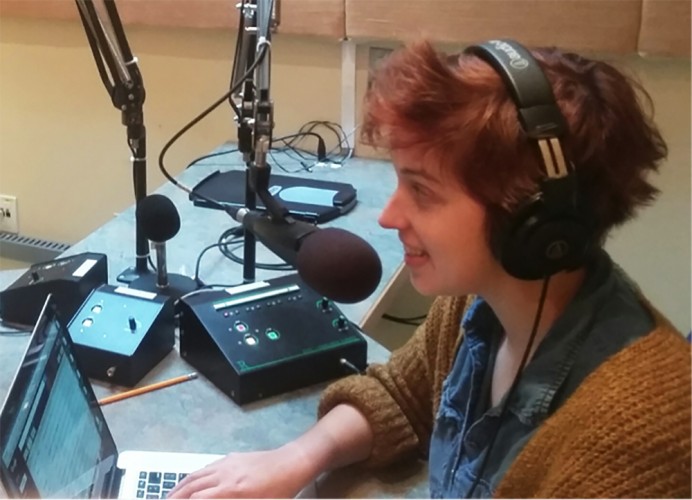Teaching the next journalists

caption
A young journalist doing an interview at the University of King’s College.Journalism schools search for ways to better prepare students
In the spring of 2014, Steve Doig delivered a lecture on investigative journalism for more than 1,000 students who signed up in more than 100 countries. When the lecture ended and students began asking questions, Doig wasn’t there to answer them in person.
No, he didn’t bolt from the classroom. Actually, while sipping a glass of French wine and eating a baguette with an assortment of cheese, meat and fruit, he typed responses to questions posted to online message boards using the wireless Internet of a small stone farmhouse in southwest France. “It was a marvelous place to do that kind of thing,” he says.
Far from a typical classroom lecture, Doig was leading a MOOC, a massive online open course, set up by the European Journalism Centre — Europe’s international journalism training institute based in the Netherlands. The students watched lectures recorded earlier that year from Doig’s classroom at Arizona State University, then completed the course work and asked questions through online message boards in real time. This course just happened to coincide with a vacation Doig was taking with his wife.
Students can attend MOOCs from anywhere in the world
“MOOCs are a way to deliver (training) to journalists and others,” Doig says. “There were a lot of people who weren’t journalists taking this. People who were working for NGOs or other organizations that care about data don’t have access… to direct seminars or universities.”
MOOCs are one way journalism education is reacting to the changes. Many schools including the University of Nevada, Reno and the University of Florida are overhauling their curricula and upgrading facilities to better train their students. Teaching hospital models are used to give students real world experience in addition to the theory and basics of journalism. As more news organizations use video game technology to present news stories, journalism students need to learn to do that.
News ways of teaching
Journalism educators and professionals agree that journalism schools need to keep changing to keep up with the ever-evolving field. It’s not enough to teach students the basic tenets and ethics of journalism anymore. Students also need visual literacy — the knowledge of design and writing for all platforms.
In the fall of 2014 the University of Nevada, Reno’s journalism school reorganized the beginner level classes to focus more on visual storytelling. “Our feeling was visual literacy is becoming more and more important,” says Associate Dean Donica Mensing. “That includes coding, mapping, how to do a visual tweet, and how do you think about colour choices and fonts and getting students to be much more conscious.”
Beginner students also take an introduction to journalism course focused on what’s happening in journalism today. Along with these two courses, students also take an intensive writing class and a multimedia class. “We think of it as a set of competencies,” says Mensing. “When they enter the major, they’ve had experience in writing in a lot of different ways, not just a standard AP-style story. They think about writing for different audiences on different platforms and they have a very strong design sense.”
UNR’s graduate level journalism courses were first redesigned in 2007 with an eye to public engagement, and continue to evolve. Mensing wants her students to consider the kind of journalist they want to be and she wants them to have a collaborative experience. To make all that happen, the university created classes called News Studios — project-based classes for graduates to bring their strengths together to create something special. One class in fall 2015 created mini-documentaries, and another did bilingual political coverage in Latino neighbourhoods in Reno.
The University of Florida also encourages student collaboration. Over the past five years, the university took its separate, competing newsrooms and consolidated them into a collaborative media hub called the Innovation News Center. Matt Sheehan, Director of the INC, says this not only caught the school up to the industry but launches it into the future.
“Our mission with the INC is to push the boundaries and experiment with new platforms,” he says. “We serve as a canary in the coal mine for what’s coming next in the industry.”
The INC transformed from several dank, dungeon-esque and competing newsrooms with isolating cubicles into a bright, open, collaborative classroom. Sheehan says the INC’s open and collaborative space provides students with a richer education.
“We feel the immersive, real world opportunities we provide our students hyper-charge the curriculum,” he says. “We’re able to not only give them the theoretical background, but we’re able to allow them to (apply) them in real world, real stakes environments.”
The INC building hosts six radio and four television stations. The stories the students write are put directly into the field for consumption by real audiences.
Sheehan taught at the University of Maryland, which he says has the “unfair advantage” of being near the United States capital. The INC was created to give the University of Florida an advantage over other schools.
“We don’t have a major media market in our backyards,” Sheehan says. “So we try to create what I call a ‘Top-10’ market experience in a much smaller market. In a market (our size), you would usually only see two or three people covering the entire thing, whereas we have a workforce of 350. We also have nine news managers where you’d usually only see one.”
Gamification, seriously
Jeff Jarvis, a journalism professor at the City University of New York’s Graduate School of Journalism, says training journalism students for the future is the key to journalism’s success. He says that just as it took 150 years after Gutenberg’s printing press was invented for newspapers to come along, journalism has yet to use the Internet to its full potential.
“We don’t know what the Internet is yet,” he says. “We’re still replicating our old models in this new world. At some point, people are going to start radically re-inventing what news can be, and that’s going to be the students.”
Digital news outlets, like the Guardian, the Times of India, and Al-Jazeera, are introducing the gamification of news — using videogame mechanics in a journalistic context — into their platforms. Raul Ferrer Conill, a Ph.D. candidate at Karlstad University in Karlstad, Sweden who studies gamification in journalism, says the main goal is to engage younger users with news.
“What journalism students need to know is this practice is out there,” he says. “Bigger actors within the journalism industry are starting to experiment with it. They need to be aware of the possible solutions it offers, but also aware of the problems with the gamification of news.”

caption
An Al-Jazeera article on pirate fishing is interactive.Gamified websites like the Bleacher Report allow amateur reporters to advance in a ranking system based on how many people like their articles. Conill says students must write real news — that is, not the Kardashians — instead of appealing to metrics.
The gamification of news offers an easier way to engage with difficult content. Al-Jazeera gamified an entire story about pirate fishing in Sierra Leone, says Conill. “They managed to create a storytelling technique that’s very compelling,” he says. “What it does is make people want to read the whole thing. I think that’s eventually where we’re headed if gamification stays within journalism.”
Sharing information
Arizona State University has adopted a “teaching hospital” model. For Doig the transition to this model was easy, thanks to a supportive faculty. Change can be sometimes be difficult. “The most resistance probably comes from the most senior faculty members,” Doig says.
“I certainly have strong ideas about how my course should be taught. I recognize that some new changes showing up are things I don’t know how to do. On the other hand, I’m perfectly happy to recruit people who could teach those things.”
Sheehan of the University of Florida says journalism schools need to be aware that they can get hurt if they move too slowly. “We are at a point in our industry when things change every six weeks. When you have a process that takes 18 months at the quickest to identify a problem, then find and implement a solution, then another four years before the curriculum changes has officially gone through… It’s a liability.”
For campuses meeting with resistance, Doig of Arizona State offers some advice on making curricular reform less of a dirty word.

caption
Innovative J-schools produce innovative young journalists.“Even if you recognize change that is needed, don’t be overly ambitious about it without taking into account where resistance might come from,” he says. “Find a way to bring along the people who might resist it… Give them something out of the change that they can buy into.”
Doig also encourages sharing information between schools. Collaborative effort means better journalism schools for all.
“We get a lot of visitors coming through our school,” he says. “Deans, chairs, and administrators from other universities that want to have the same kind of success that we’re having. They will send two or three people, they’ll see our classes and talk with people like me, ask questions… I think that’s a good thing. That way people can go back and say ‘here, we learned something’.”
Jarvis of the City University of New York says when the going gets tough, get tougher.
“Hack the system,” he says. “Reinvestigate what the field needs. Talk to your graduates out in the marketplace about what they wish they knew, or what they had to teach themselves. Question and change your curriculum constantly.”
Jarvis says disruption in journalism is more important than the status quo. Students are the future of journalism and need to be adequately prepared. “Journalism is changing rapidly,” he says.
Jarvis says leaders in digital journalism like Vox, Quartz, and the Huffington Post all expect journalism students to have new and updated skills. Skills in multimedia and data storytelling, audience development, and programming are required to fill the new job descriptions in the journalism market.
“If we don’t become expert enough ourselves in teaching these skills,” says Jarvis, “then we are ill-serving the students in the field.”

